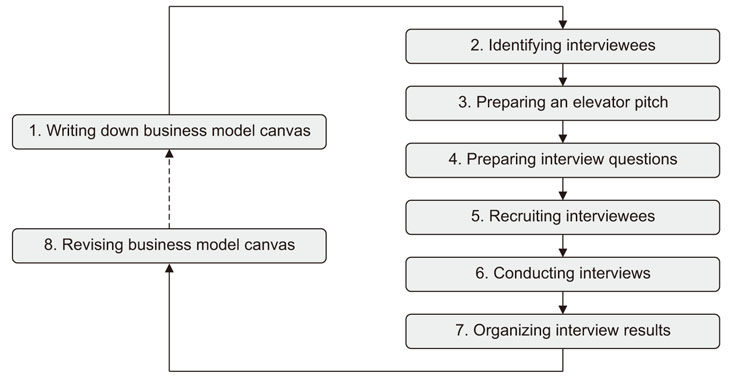Healthc Inform Res.
2018 Jan;24(1):79-85. 10.4258/hir.2018.24.1.79.
Customer Discovery as the First Essential Step for Successful Health Information Technology System Development
- Affiliations
-
- 1Institute of Biomedical Engineering, Chungnam National University, Daejeon, Korea. gongcop@cnu.ac.kr
- 2Biomedical Research Institute, Seoul National University Hospital, Seoul, Korea.
- 3Chungnam National University School of Medicine, Daejeon, Korea.
- 4Department of Biomedical Engineering, Chungnam National University College of Medicine and Chungnam National University Hospital, Daejeon, Korea.
- 5Institute of Medical and Biological Engineering, Medical Research Center, Seoul National University College of Medicine, Seoul, Korea.
- KMID: 2403299
- DOI: http://doi.org/10.4258/hir.2018.24.1.79
Abstract
OBJECTIVES
Customer discovery (CD) is a method to determine if there are actual customers for a product/service and what they would want before actually developing the product/service. This concept, however, is rather new to health information technology (IT) systems. Therefore, the aim of this paper was to demonstrate how to use the CD method in developing a comprehensive health IT service for patients with knee/leg pain.
METHODS
We participated in a 6-week I-Corps program to perform CD, in which we interviewed 55 people in person, by phone, or by video conference within 6 weeks: 4 weeks in the United States and 2 weeks in Korea. The interviewees included orthopedic doctors, physical therapists, physical trainers, physicians, researchers, pharmacists, vendors, and patients. By analyzing the interview data, the aim was to revise our business model accordingly.
RESULTS
Using the CD approach enabled us to understand the customer segments and identify value propositions. We concluded that a facilitating tele-rehabilitation system is needed the most and that the most suitable customer segment is early stage arthritis patients. We identified a new design concept for the customer segment. Furthermore, CD is required to identify value propositions in detail.
CONCLUSIONS
CD is crucial to determine a more desirable direction in developing health IT systems, and it can be a powerful tool to increase the potential for successful commercialization in the health IT field.
Keyword
MeSH Terms
Figure
Reference
-
1. Money AG, Barnett J, Kuljis J, Craven MP, Martin JL, Young T. The role of the user within the medical device design and development process: medical device manufacturers' perspectives. BMC Med Inform Decis Mak. 2011; 11:15.
Article2. Park SM, Hwang SO, Yoon YR. Needs assessment of potential users for tele-health surveillance system. J Korean Soc Med Inf. 2005; 11(1):27–33.3. Shah SG, Robinson I, AlShawi S. Developing medical device technologies from users' perspectives: a theoretical framework for involving users in the development process. Int J Technol Assess Health Care. 2009; 25(4):514–521.
Article4. Taylor PR. An approach to designing viable and sustainable telehealth services. Stud Health Technol Inform. 2013; 188:108–113.5. Flores-Vaquero P, Tiwari A, Alcock J, Hutabarat W, Turner C. A product-service system approach to telehealth application design. Health Informatics J. 2016; 22(2):321–332.
Article6. Dhillon JS, Ramos C, Wunsche BC, Lutteroth C. Designing a web-based telehealth system for elderly people: an interview study in New Zealand. In : Proceedings of 24th International Symposium on Computer-Based Medical Systems (CBMS); 2011 Jun 27-30; Bristol, UK: p. 1–6.7. Batova T, Clark D, Card D. Challenges of lean customer discovery as invention. In : Proceedings of IEEE International Professional Communication Conference (IPCC); 2016 Oct 2-5; Austin TX: p. 1–5.8. Blank S. The four steps to the epiphany: successful strategies for products that win. Foster City (CA): Cafepress;2005. p. 17–28.9. MaRS. The Customer Development Model (CDM), product development and technology startups [Internet]. Toronto, Canada: MaRS;c2018. cited at 2018 Jan 24. Available from: https://www.marsdd.com/mars-library/the-customer-development-model-cdm-productdevelopment-and-technology-startups/.10. National Science Foundation. Innovation Corps (ICorps) [Internet]. Alexandria (VA): National Science Foundation;c2017. cited at 2018 Jan 24. Available from: https://www.nsf.gov/news/special_reports/i-corps.11. Venturewell. I-Corps: tapping the enormous potential of NSF-funded science and engineering innovations [Internet]. Hadley (MA): Venturewell;c2017. cited at 2018 Jan 24. Available from: https://venturewell.org/i-corps.12. Robinson L. I-Corps and the business of great science. JOM. 2012; 64(10):1132–1133.
Article13. Blank S. Embrace failure to start up success. Nature. 2011; 477(7363):133.
Article14. Connick W. Cold calling: one of the least liked tasks in sales [Internet]. [place unknown]: thebalance.com;c2017. cited at 2018 Jan 24. Available from: https://www.thebalance.com/what-is-cold-calling-2917371.15. Connick W. What is warm calling in sales? [Internet]. [place unknown]: thebalance.com;c2017. cited at 2018 Jan 24. Available from: https://www.thebalance.com/what-is-warm-calling-2917380.16. Murphy L, Helmick CG. The impact of osteoarthritis in the United States: a population-health perspective. Am J Nurs. 2012; 112:3 Suppl 1. S13–S19.17. Lee S, Kim SJ. Prevalence of knee osteoarthritis, risk factors, and quality of life: the fifth Korean National Health and Nutrition Examination Survey. Int J Rheum Dis. 2017; 20(7):809–817.
Article18. Bendixen RM, Levy CE, Olive ES, Kobb RF, Mann WC. Cost effectiveness of a telerehabilitation program to support chronically ill and disabled elders in their homes. Telemed J E Health. 2009; 15(1):31–38.
Article
- Full Text Links
- Actions
-
Cited
- CITED
-
- Close
- Share
- Similar articles
-
- Successful use of customer relationship management system in hospital healthcare centers
- Development of Customer Relationship Management System in the Healthcare Domain Using Data Mining
- Moderating Effect of Support on the Relationship between Customer Violence Experience and Mental Health of Customer Service Workers
- Information System Success Model for Customer Relationship Management System in Health Promotion Centers
- The Causality among the Internal Customer Satisfaction, the External Customer Satisfaction and the Customer Loyalty of Medical Service



